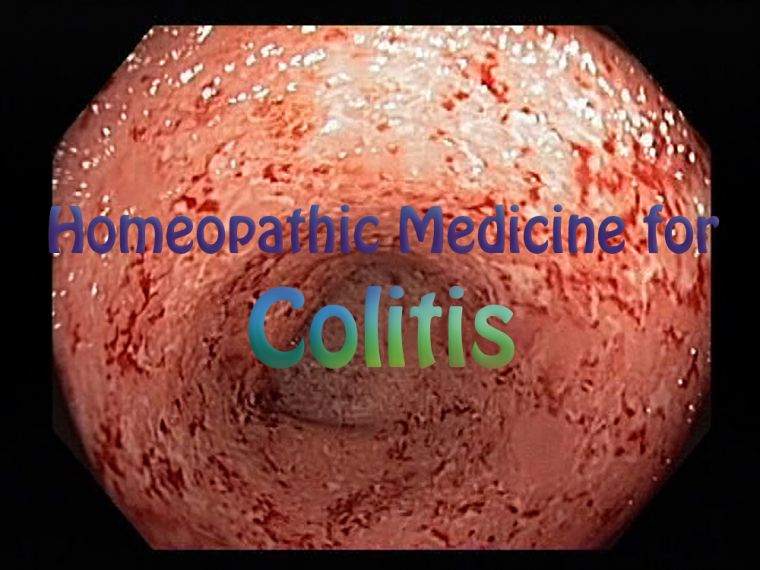Homeopathic Medicine for Colitis
Colitis – Inflammation of The Large Intestines – Colon
UNHEALTHY GROWTHS IN THE COLON LINING
Sometimes tissue in the colon changes—perhaps as a result of genetics, a high fat, low fibre diet, or exposure to cancer-causing substances. As this tissue changes, growths—polyps or cancers—may form on the colon lining.
POLYPS
A “benign” polyp is a non-cancerous growth. It can be as small as a pea or as large as a golf ball. The larger the polyp, the greater is its chance of turning into cancer. Early removal of “benign” polyps may prevent them from changing into cancers.
CANCERS
A cancer is made up of abnormal cells that are growing out of control. Cancers are most often the size of a mushroom or larger.
They can grow into the colon lining and spread to other parts of the body. The sooner cancers are removed, the greater the chance of preventing cancer spread.
CANCER SPREAD
If cancer cells break off, they may travel through the colon lining into the lymph and blood vessels. These vessels may carry the cancer cells to the lymph glands, liver, lungs, or other organs, starting new cancers. This cancer spread is called matastasis.
Allium sativum (Thrice a day): Colitis with stools containing shreds of intestinal mucous membrane. Great hunger. Especially indicated in high fevers and fleshy persons.
Aloe soc. (Four times a day): Constant bearing down in the rectum. Bleeding. Rectum feels sore and hot, and is relieved by Cold water. Lot of mucus and wind is expelled with stools and the pain remains in the rectum after passing stools. Gurgling in the abdomen.
Argentum nit. (Thrice a day): Membranous stools. Flatus expelled with a noise. Constipation. Pains in the region of the spleen.
Cadmium sulph. (Thrice a day): Gelatinous stools. Cutting pains in the bowels and kidneys.
Cantharis (Four times a day): Smell of food causes nausea and vomiting. Stools are membranous. Colic. Flatulence.
China off. (Thrice a day): Yellowish, watery stools. Absence of pain. Some flatus with stools.
Colchicum autum. (Thrice a day): Distention of abdomen with wind. Pain in the region of the liver. Stools contain white shreds.
Colocynthis (Thrice a day): Severe cutting pains in the abdomen forcing the patient to bend double. Pains worse after anger. Bitter taste in the mouth.
Ficus ind. Q (Thrice a day): Hemorrhage before evacuation. Stools are bloody with pure red blood and colic.
Kalium bich. (Thrice a day): Chronic intestinal ulceration and perforation with cutting pain, soreness and burning. Diarrhea or dysentery. Stools brown, jelly-like and frothy.
Lachesis (Twice a day): Colitis with offensive diarrhea alternating with constipation. Abdomen very sensitive to pressure.
Magnesium carb. (Thrice a day): Abdomen distended. Diarrhea. Stools are green and forced out.
Mercurius cor. (Four times a day): Diarrhea or dysentery due to ulceration of the intestines with incessant tenesmus. Stool hot, containing blood and mucus pieces.
Mercurius dulc. (Four times a day): Stools are scanty and are mixed with blood, mucus and bile. Anus sore and burning.
Selenium met. (Thrice a day): Colitis on account of tuberculosis of the peritoneum.
Sepia (Thrice a day): Enterocolitis. The leading symptom for the choice of this remedy is “always worse after taking milk. ”
Staphysagria 200 (Twice a day): Simple or ulcerative colitis after insults and injuries like after rape.
Sulphur (One dose daily): Treatment should be started and ended with this remedy.
Terebinthiniae (Thrice a day): Enterocolitis with hemorrhage and ulceration of the bowels.
Thuja occ. 1M (One dose only): Colitis on account of amoebic dysentery.
NOTE: In chronic ulcerative colitis, the intestine is very irritated and develops raw areas. It results from prolonged diarrhea or dysentery. Cancer can occur if the disease remains for many years. It is second only to lung cancer as a fatal cancer. It is preventable in 95% cases. There is a polyp or a tissue mass which forms the cancer. It can be detected by fecal occult blood test in a laboratory or by Colonoscopy. When detected, the cancerous portion is removed surgically. Such Surgery is called ‘colostomy’. Surgery is still most commonly used for cancer of the colon and rectum. Colon has no essential function in regard to nutrition. It merely converts the waste of the food to a solid stool. So the infected portion of the colon is removed and its further function is taken over by the remaining portion of the colon. Greater the portion of the colon removed, greater is the reduction in the solidity of the stool and it becomes more watery. Surgery of the rectum is complicated because its lower portion (anus) contains the sphincter muscles which control the bowel action. In such a Surgery, the end of the healthy remaining colon is connected through the wall of the abdomen to a plastic bag in which the stool is discharged.
Colonoscopy: Colonoscopy is an advanced technique for viewing the whole colon. A screen or eye piece may be used. The colonoscope is a thin, lighted, flexible tube which is moved through the colon. It is used both to diagnose growths and to confirm findings of other tests. It can also be used to remove small polyps and to collect tissue samples for analysis. The patient is lightly sedated during the procedure.
Ask A Doctor
You can now consult our well qualified homeopathic doctor for homeopathic treatment of any kind of disease. The consultancy fee is only Rs 200/- . Post making the payment you will be asked about the disease and the symptoms of your disease. Based on your problem, the doctor will instruct you with the name of the medicine and the method of having the medicine. You can make the payment via Paytm App or your debit card. For more inquiry contact on the WhatsApp number - +919006242658


Comments are closed, but trackbacks and pingbacks are open.